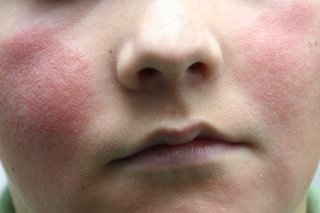Everything You Need to Know About Slap Cheek: A Comprehensive Guide for Parents
Hello there, super moms and dads! ? Are you concerned about that rosy glow on your little one’s cheeks that’s been hanging around a bit too long? Well, you’ve come just to the right place. Welcome to our all-in-one guide on Slap Cheek (Fifth Disease), where we’re going to cover all the bases to help you understand, manage, and ease your worries about this common childhood ailment. So, let’s dive into the world of rashes, itchy cheeks, and everything in-between with our handy guide!
What Is Slap Cheek?
Slap Cheek, also endearingly known as Fifth Disease, is a viral infection that’s most commonly seen in children. Its medical name is Erythema infectiosum, and it gets its “Slap cheek” nickname because of the distinctive red rash that looks as though the child has been gently slapped about the cheeks. But worry not! Despite its appearance, it’s usually a mild illness caused by the human parvovirus B19.
Common Symptoms to Spot
- Mild Fever: Some kiddos may develop a slight fever at the onset of the illness.
- Bright Red Cheeks: The hallmark of Slap Cheek, these “slapped” cheeks are hard to miss!
- Rash on the Body: After the cheeks get rosy, a lacy-patterned rash can spread to the body.
- Mildly Itchy Skin: Many children find the rash to be a tad itchy.
- Runny Nose and Sore Throat: These are common early signs that may be mistaken for a cold.
Don’t fret if these symptoms ring a few alarm bells! Even though the rash can look pretty dramatic, Slap Cheek is generally a mild illness, and most kids bounce back in a jiffy!
Transmission: How Does It Spread?
Understanding how Slap Cheek zips around can help you take steps to prevent its spread. This cheeky virus is most contagious before the rash appears—when it seems like your kiddo just has a cold. They can pass it to others through:
- Respiratory Secretions: Like sneezing and coughing – oh, those pesky germs!
- Touch: From one tiny hand to another – sharing is caring, but not so much in this case!
Once the rash is out in all its glory, the contagious stage is generally over. Whew! This means your little one can go back to school or day care without any risk to their pals. ?
Diagnosis and When to Seek Medical Advice
If you suspect your child has Slap Cheek, a quick visit to the pediatrician can confirm it. While most cases are diagnosed by looking at the rash and reviewing symptoms, a blood test can sometimes be done to check for the virus or antibodies.
Tip: It’s always best to see a doctor if you’re unsure or if the following occurs:
- Your child seems very unwell or the rash is getting worse.
- The fever is high (above 38°C or 100.4°F) and not settling with the usual care.
- If your child has a weakened immune system, an underlying health condition, or if there’s a pregnant person in the household.
It’s super key to get these checks, as folks with certain conditions or pregnant individuals can be more at risk from the virus.
Now that we’ve covered the basics, let’s dive a little deeper into what to expect if your child has been diagnosed with Slap Cheek, and how to keep their spirits up while their immune system does all the hard work.

5 Things Parents Should Know in Preparing for Slap Cheek
Preparation is key when dealing with Slap Cheek. Here are five savvy tips to ensure you’re on top of things!
1. Recognize the Early Warning Signs
Keep a lookout for early symptoms like a runny nose, mild fever, and fatigue as these can be the precursors to the rash. Catching these early signs can help you anticipate the need for a bit more TLC before the rash makes an appearance.
2. Home Comforts Make a Difference
Your home should be a comforting sanctuary for your little one. Stock up on soft tissues, have their favorite blankets at hand, and maybe even a special comfort toy. A soothing, nurturing environment can really make all the difference in their recovery.
3. Keep the Itch at Bay
While the rash itself is not typically very bothersome, some children may experience itchiness. Have some calamine lotion or an oatmeal bath product ready to soothe any skin irritations. Plus, keep those little fingers distracted to prevent scratching!
4. Hydration Is a Must
Ensure your child stays well-hydrated. Fever can lead to dehydration, and water is the best kind of liquid love when it comes to recovery. Not so keen on water? A little flavor from diluted fruit juices can often do the trick to keep those fluids going in.
5. Prepare for Immune System Warfare
Boost your child’s diet with immune-supporting foods rich in vitamins and minerals. Brightly colored fruits and veggies, lean proteins, and whole grains can help their tiny bodies become super-efficient at fighting off the virus. Also, good hand hygiene practices can prevent the spread of the virus within the household and beyond.
Treatment and Home Remedies
As a viral infection, Slap Cheek doesn’t have a specific medicine to make it vanish, but that doesn’t mean you can’t bring relief to your child. Home remedies and over-the-counter treatments aimed at easing symptoms can be incredibly effective.
- Ease the Fever and Pain: Children’s acetaminophen or ibuprofen can help lower a fever and alleviate minor aches. Remember to always follow the dosage guidelines for your child’s age and weight.
- Provide Plenty of Rest: Let your kiddo’s body focus on healing – that means more nap times, cozy movie afternoons, and perhaps delaying super active play dates for a bit.
- Soothe the Rash: Cool compresses and soothing lotions can offer relief from the rash if it’s causing discomfort.
Rest assured, in most cases, your child will be their energetic, joyful self in no time, and Slap Cheek will be nothing but a memory of when their cheeks were just a tad rosier. ?
Preventing Slap Cheek in the Future
Whilst there’s no vaccine available for human parvovirus B19, good sanitary habits can reduce the risk of your child catching it again:
- Instill Good Hygiene: Teach your kids about the importance of handwashing, especially before meals and after playing outside.
- Clean Commonly Touched Surfaces: Regularly wipe down toys, doorknobs, and other surfaces that might collect germs.
- Keep Sick Children Home: If there’s an outbreak at school or day care, keeping your child home can prevent the spread and reinfection.
Most children develop immunity to the virus after having it, which means once they get over this cheeky little infection, they’re unlikely to catch it again. So, here’s to health, happiness, and heaps of smiles that don’t involve rosy cheeks from Slap Cheek!
Remember, our guide is here to empower you with knowledge, not to replace the personalized advice of a healthcare professional. Always consult with your pediatrician if you’re concerned about your child’s health. Stay informed, stay prepared, and keep embracing the beautiful (and sometimes bumpy) journey of parenthood! ?
See more great Things to Do with Kids in New Zealand here. For more information see here
Disclaimer
The articles available via our website provide general information only and we strongly urge readers to exercise caution and conduct their own thorough research and fact-checking. The information presented should not be taken as absolute truth, and, to the maximum extent permitted by law, we will not be held liable for any inaccuracies or errors in the content. It is essential for individuals to independently verify and validate the information before making any decisions or taking any actions based on the articles.




